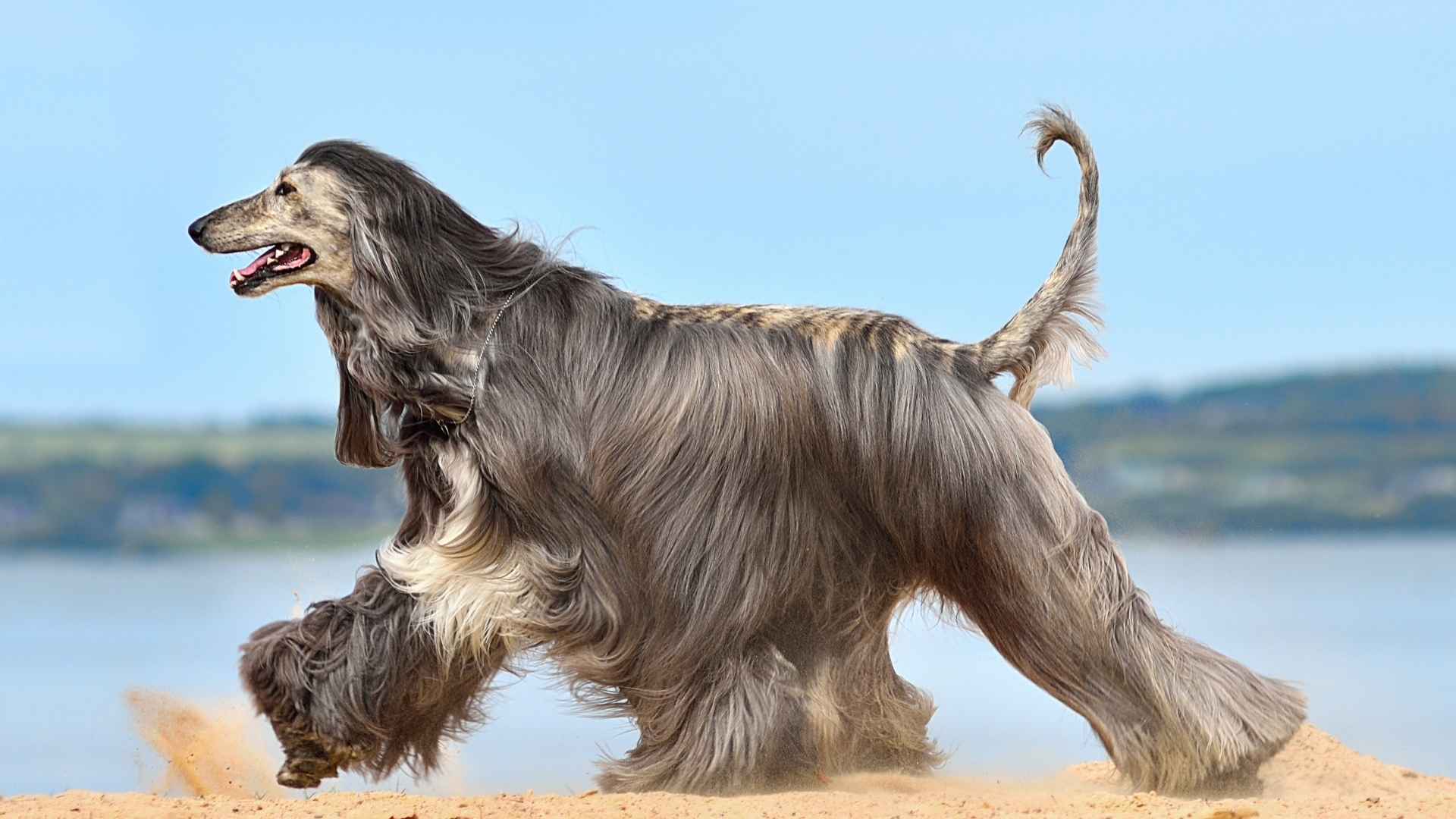There’s something truly captivating about a dog with a flowing, luxurious coat. Dogs with extended-length coats turn heads wherever they go, their soft, silky fur giving them an almost regal presence. Whether it’s the gentle sway of their hair as they move or the way their coat seems to shimmer in the sunlight, these dogs are pure elegance in motion.
But beauty isn’t the only thing they offer — these long-coated companions often have warm, affectionate personalities to match their stunning appearance. Of course, that gorgeous fur comes with its own set of responsibilities, from regular grooming to extra TLC during shedding seasons.
Still, for many dog lovers, the reward of having a fluffy best friend is well worth the effort. If you’re enchanted by dogs with magnificent, extended coats, you’re in for a treat. Let’s dive into the world of dog breeds that have luxurious, lengthy coats!
Extended Length Coat Dog Breeds
1. Afghan Hound
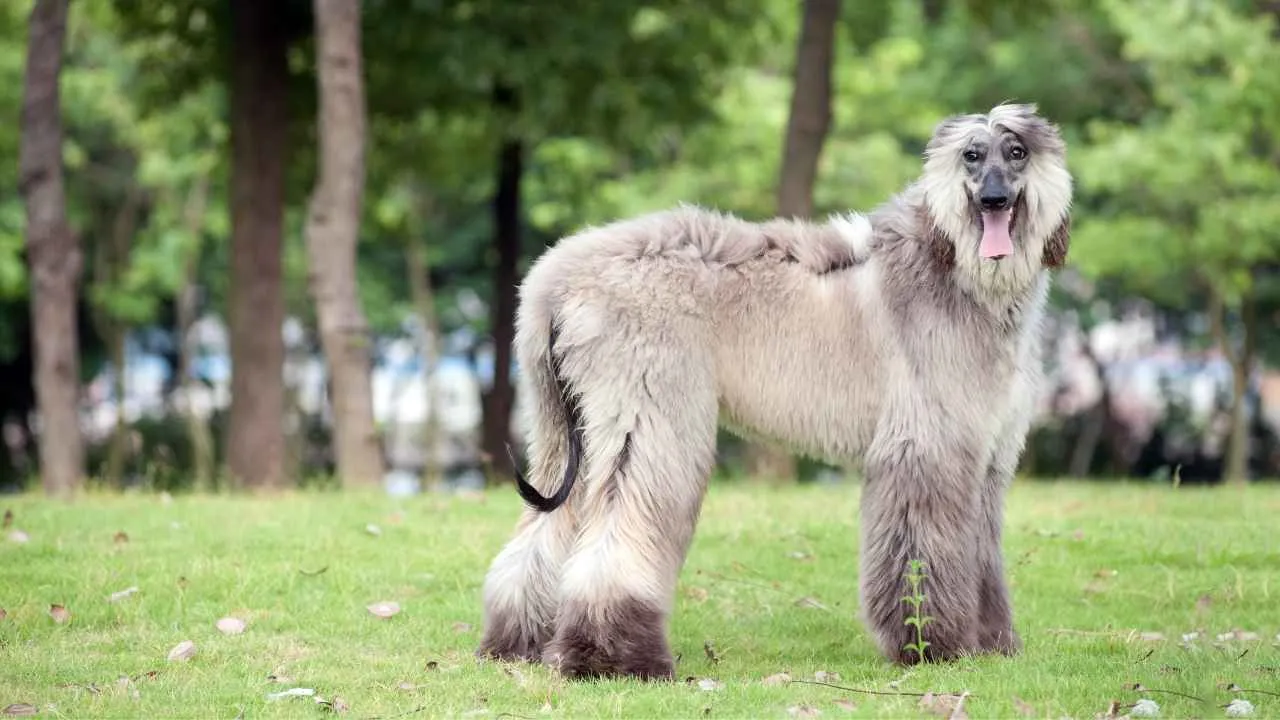
The Afghan Hound is a distinguished breed renowned for its extended-length, double-layered coat that epitomizes elegance and grace. This long, silky hair is not merely a visual attribute but a testament to the breed’s adaptability to the harsh climates of its native Afghanistan.
Afghan Hound boasts a charming personality with its fine-textured coat. The flowing appearance is further complemented by a distinctive topknot on the head and a “saddle” of shorter hair along the back, adding to its unique charm.
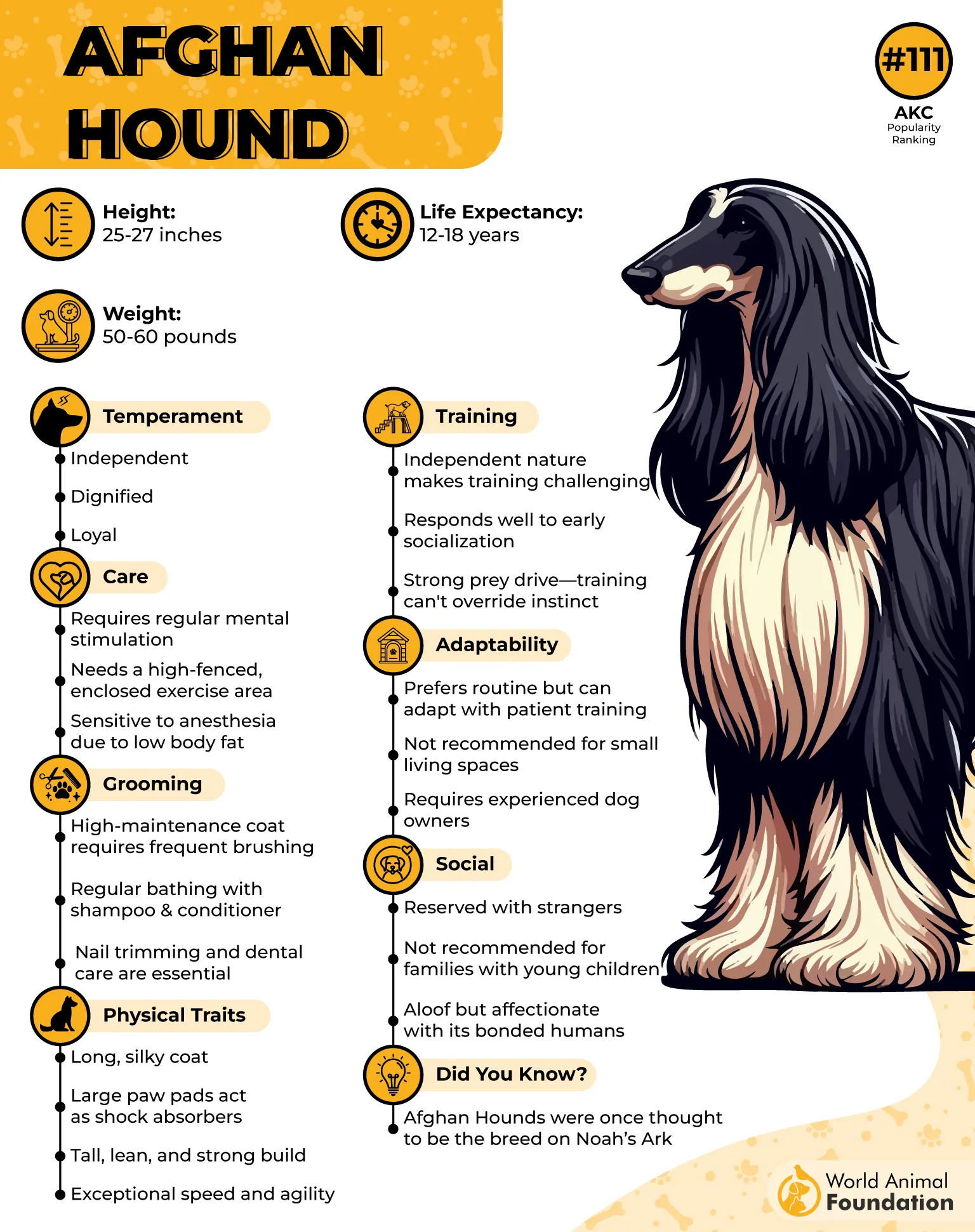
Its silky hair not only offers insulation but also helps reduce the effects of wind and cold, a vital feature for a breed originally bred to work in the mountainous regions of Afghanistan. Today, while many Afghan Hounds serve as family pets, their working dog origins continue to influence their graceful yet independent nature.
Maintaining the Afghan Hound’s luxurious coat requires diligent care. Regular grooming is essential to prevent tangling, ensuring the hair remains light and airy, moving freely with the dog’s graceful movements. Professional grooming services can assist in maintaining the coat’s health and appearance, especially for show-quality standards.
While often aloof with strangers, it forms deep bonds with its family, displaying loyalty and affection. These hunting dogs thrive in environments where they receive ample attention and care, making them cherished companions for those willing to meet their grooming and exercise needs.
2. Bearded Collie
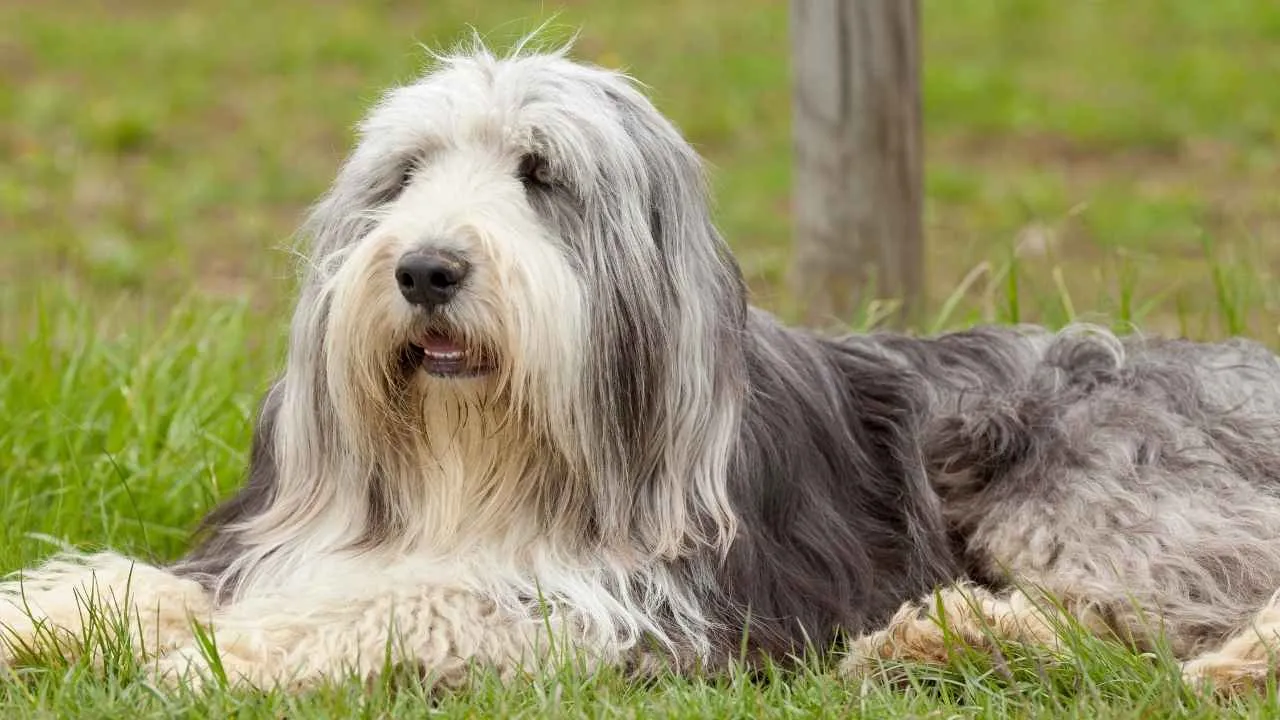
The Bearded Collie, often referred to as the “Beardie,” has a rich history as a working dog, originally bred in Scotland for herding sheep. The Bearded Collie is valued for its intelligence, agility, and endurance, as it is capable of working in harsh conditions.
The Bearded Collie’s coat serves not only as a tool for weather protection but also as a visual testament to the breed’s working heritage. As a herding dog, its coat needed to be both functional and striking, reflecting the dog’s active and purposeful life.
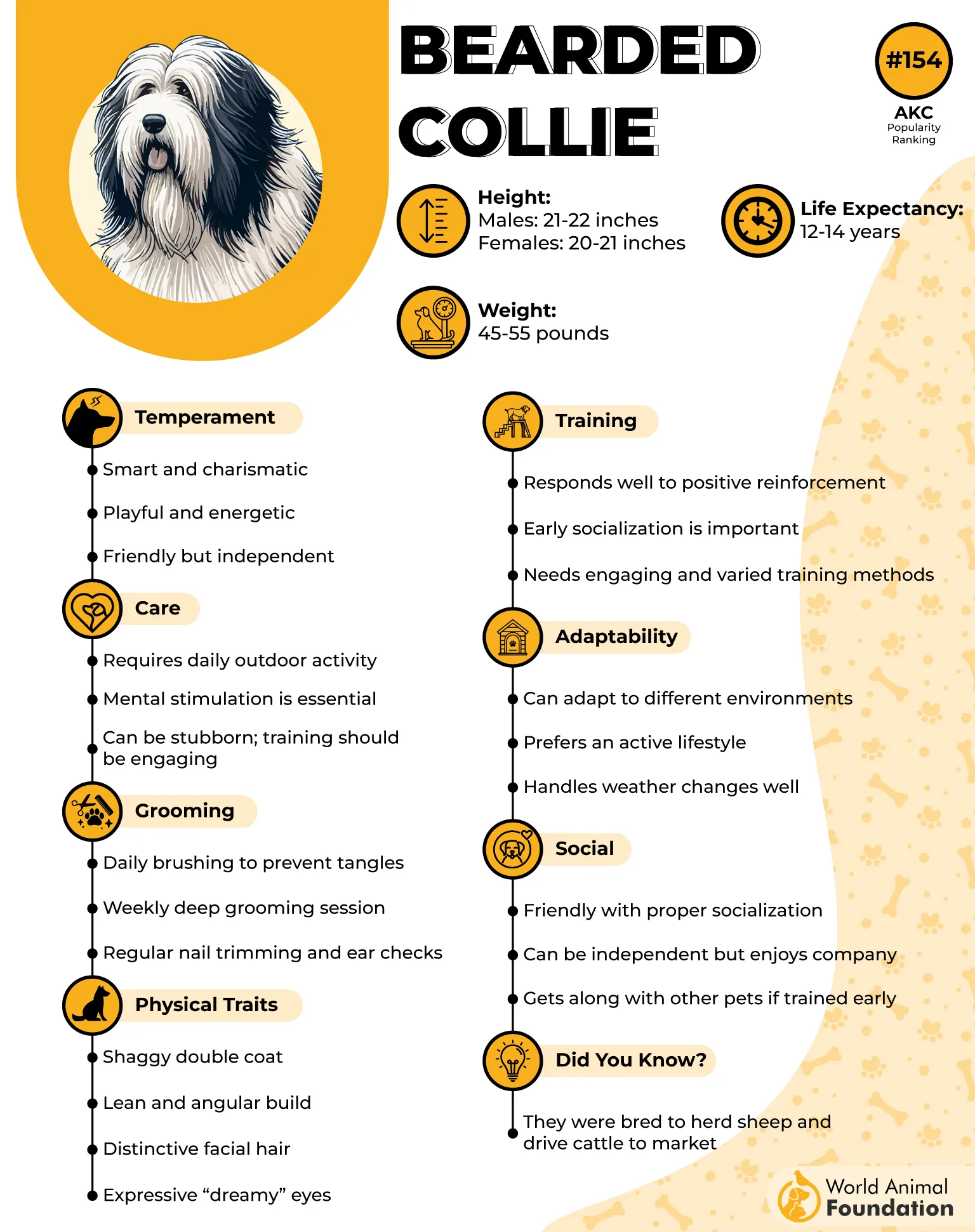
Bearded Collie has a distinctive, long, double-layered coat that is weather-resistant, helping it to endure various climates during its work on farms. The outer coat is thick and harsh, while the undercoat is soft and dense, providing insulation during long hours of herding in rough conditions.
The Bearded Collie’s coat, however, requires significant care. Regular brushing is recommended to keep the coat healthy and manageable, and some owners opt for professional grooming to maintain its pristine condition. Despite the grooming demands, the coat’s beauty remains one of the breed’s most prized attributes.
The bearded Collie’s coat is deeply tied to its history as a herding dog. It reflects the breed’s origins in Scotland, where it had to endure various weather conditions while herding sheep.
3. Briard
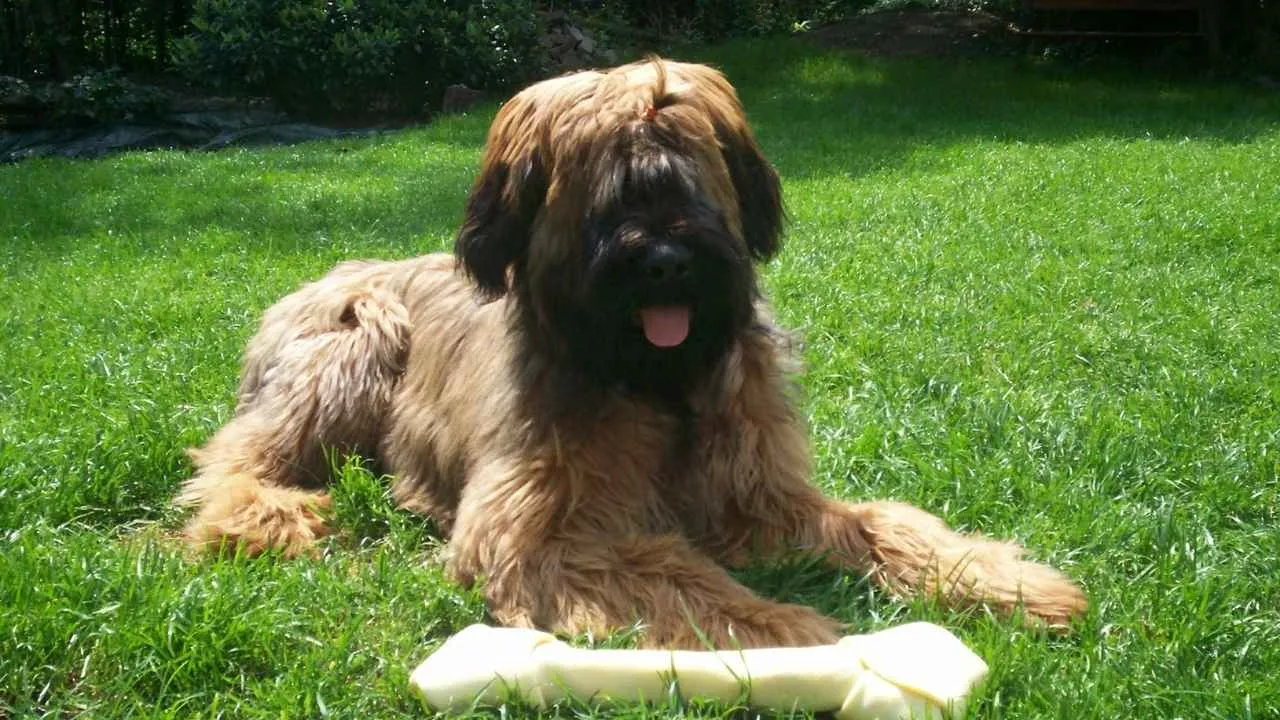
The Briard, or Berger de Brie, is a French herding dog renowned for its distinctive long, wavy double coat. This breed’s coat comprises a coarse, slightly wavy outer layer and a dense, soft undercoat, providing excellent protection against the elements.
Briard’s long, wavy double coat is a hallmark of the breed, requiring consistent grooming to maintain its beauty and health. With proper care, the Briard remains a charming and elegant companion, showcasing the breed’s rich history and distinctive appearance.
AKC describes this breed as “a heart wrapped in fur” due to its loyal and faithful temperament and friendly demeanour.
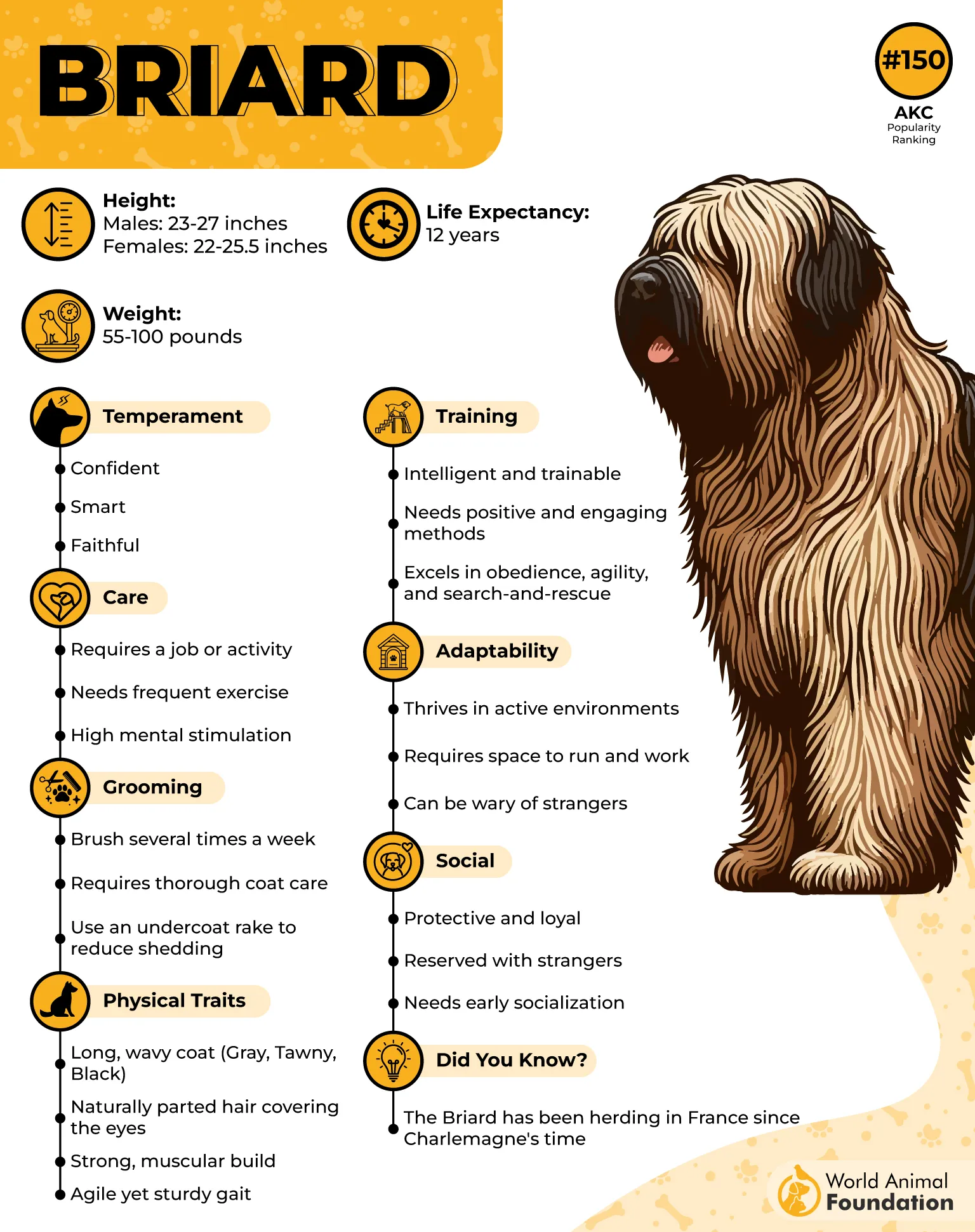
Maintaining the Briard’s coat demands consistent grooming. Brushing should be done at least three times a week to prevent matting and tangling. Using appropriate grooming tools, such as pin brushes and combs, helps in managing the coat effectively. Bathing the Briard every 6 to 8 weeks is recommended to keep the coat clean and healthy.
The Briard’s coat is not only a visual marvel but also a testament to the breed’s adaptation to its environment. The long, flowing hair protected against the harsh conditions of the French countryside.
Regular grooming is essential for the Briard to prevent matting and to keep the coat looking its best. Proper grooming also promotes healthy skin by distributing natural oils and removing debris. It’s important to use the right grooming tools and techniques to maintain the coat’s quality and the dog’s comfort.
4. Lhasa Apso
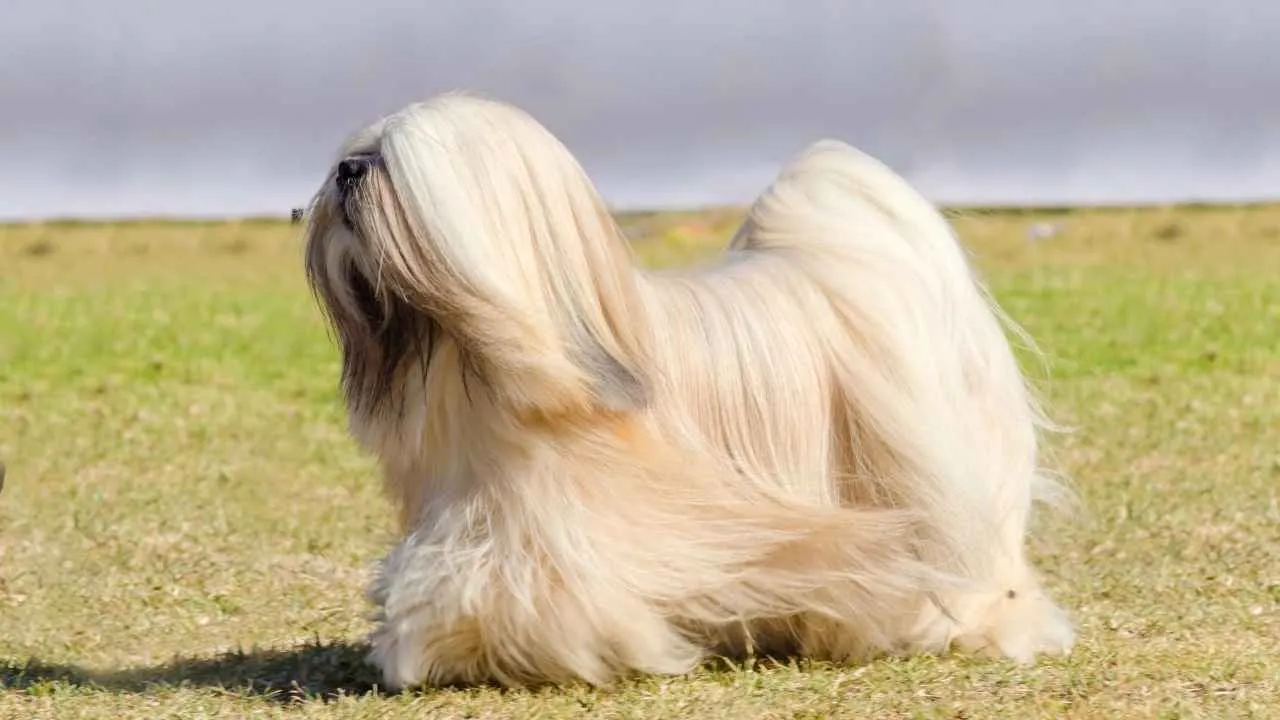
The Lhasa Apso is a small dog breed originating from Tibet, renowned for its distinctive long, dense double coat. This breed’s coat is characterized by a heavy, straight, and hard topcoat, complemented by a moderate undercoat, contributing to its regal appearance.
The coat is parted down the middle and flows over the sides, often reaching the ground, which is a hallmark of the breed’s traditional look. The Lhasa Apso’s coat serves as a protective barrier against the harsh Tibetan climate, reflecting its historical role as a sentinel in monasteries and palaces.
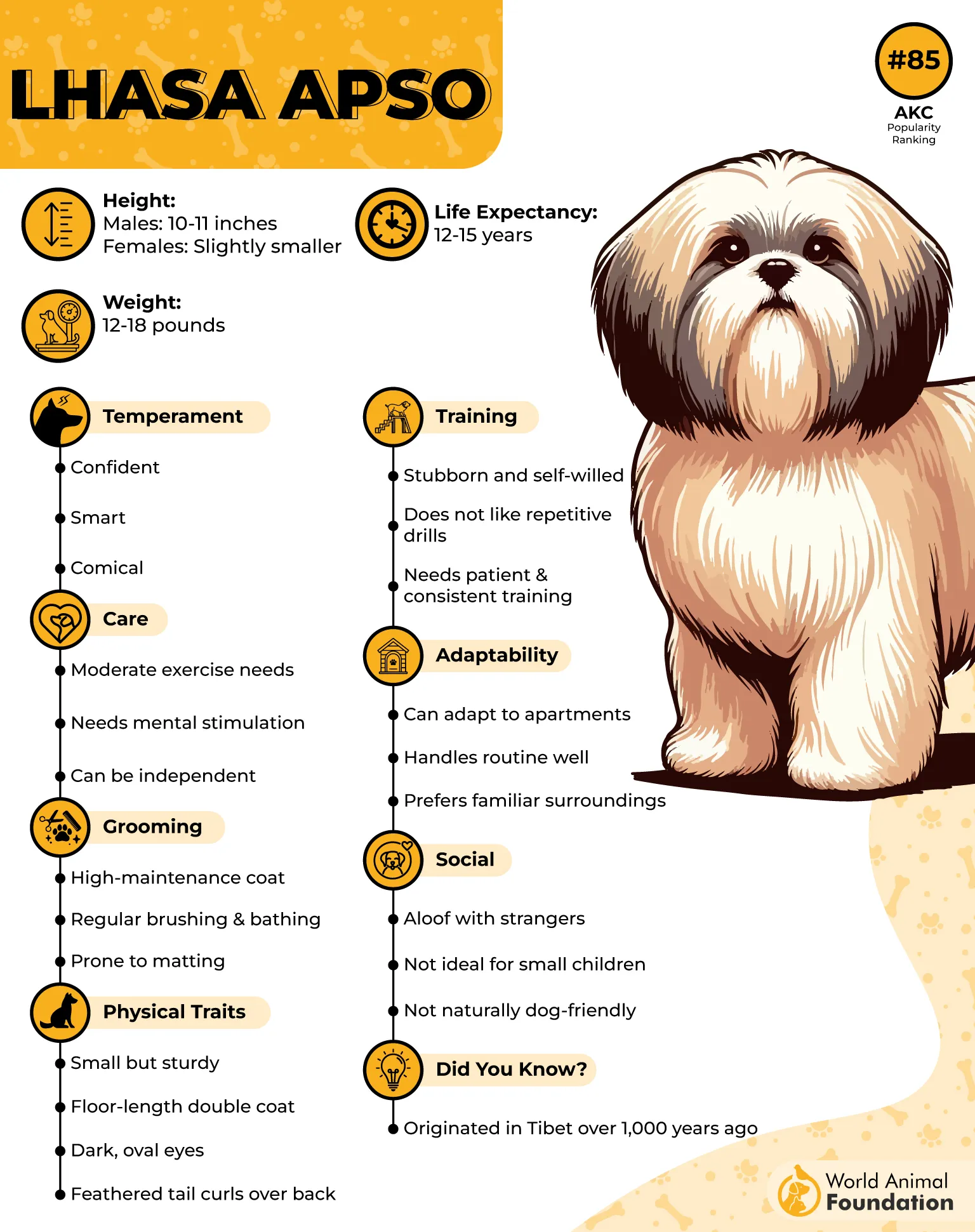
Grooming the Lhasa Apso’s long coat requires regular maintenance. Daily brushing is recommended to keep the coat in optimal condition, using appropriate grooming tools such as pin brushes and combs. Bathing should be done approximately every two weeks to maintain cleanliness and coat health.
For those who prefer a more manageable coat length, professional grooming services can trim the hair to a shorter length, making maintenance easier while still preserving the breed’s characteristic appearance.
The Lhasa Apso’s coat is not only a visual characteristic but also a testament to its adaptability and resilience. The dense coat provides insulation against cold temperatures, showcasing the breed’s origins in the high-altitude regions of Tibet.
5. Pekingese
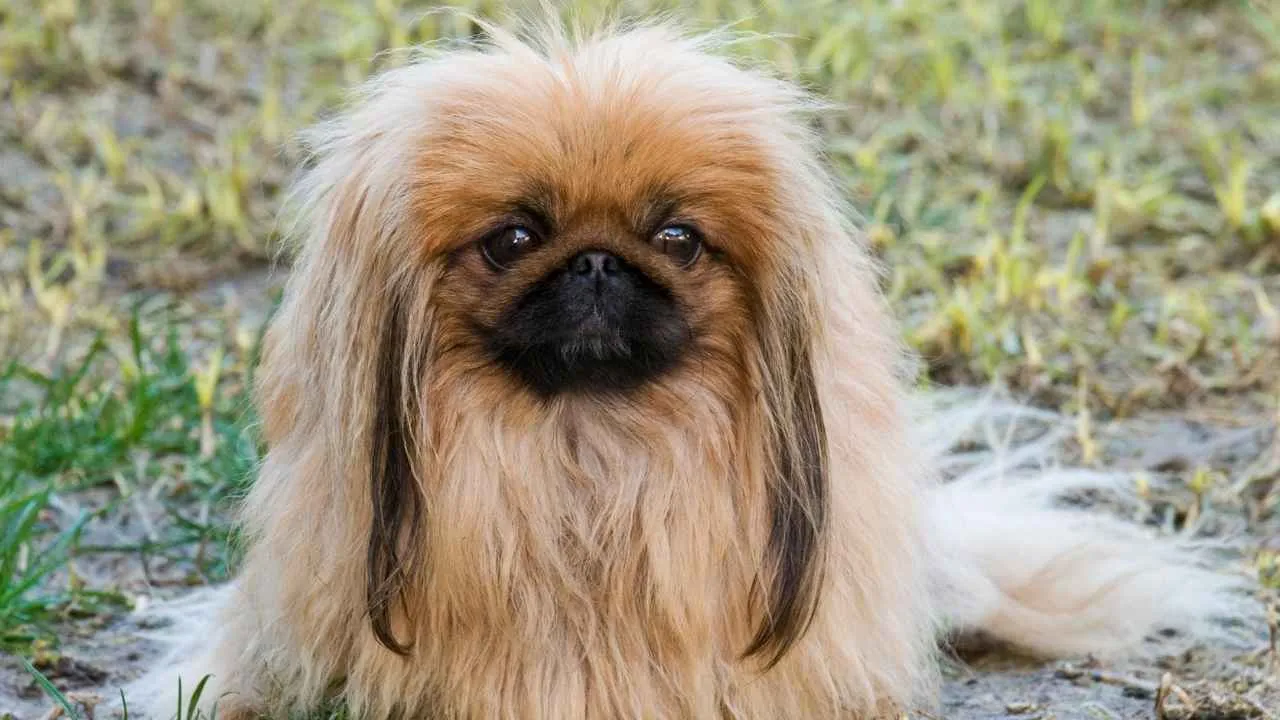
The Pekingese, a toy breed with a rich history as a companion to Chinese royalty, is renowned for its luxurious, long, flowing coat. This double-layered coat features a dense undercoat and a long, straight outer coat that hangs gracefully from the body. The coat’s texture is coarse, providing protection, while the undercoat is soft and abundant, contributing to the breed’s distinctive appearance.
Pekingese’s long, flowing coat is a defining feature that requires dedicated care. Prospective owners should be prepared for the grooming commitment involved in maintaining this breed’s distinctive coat.
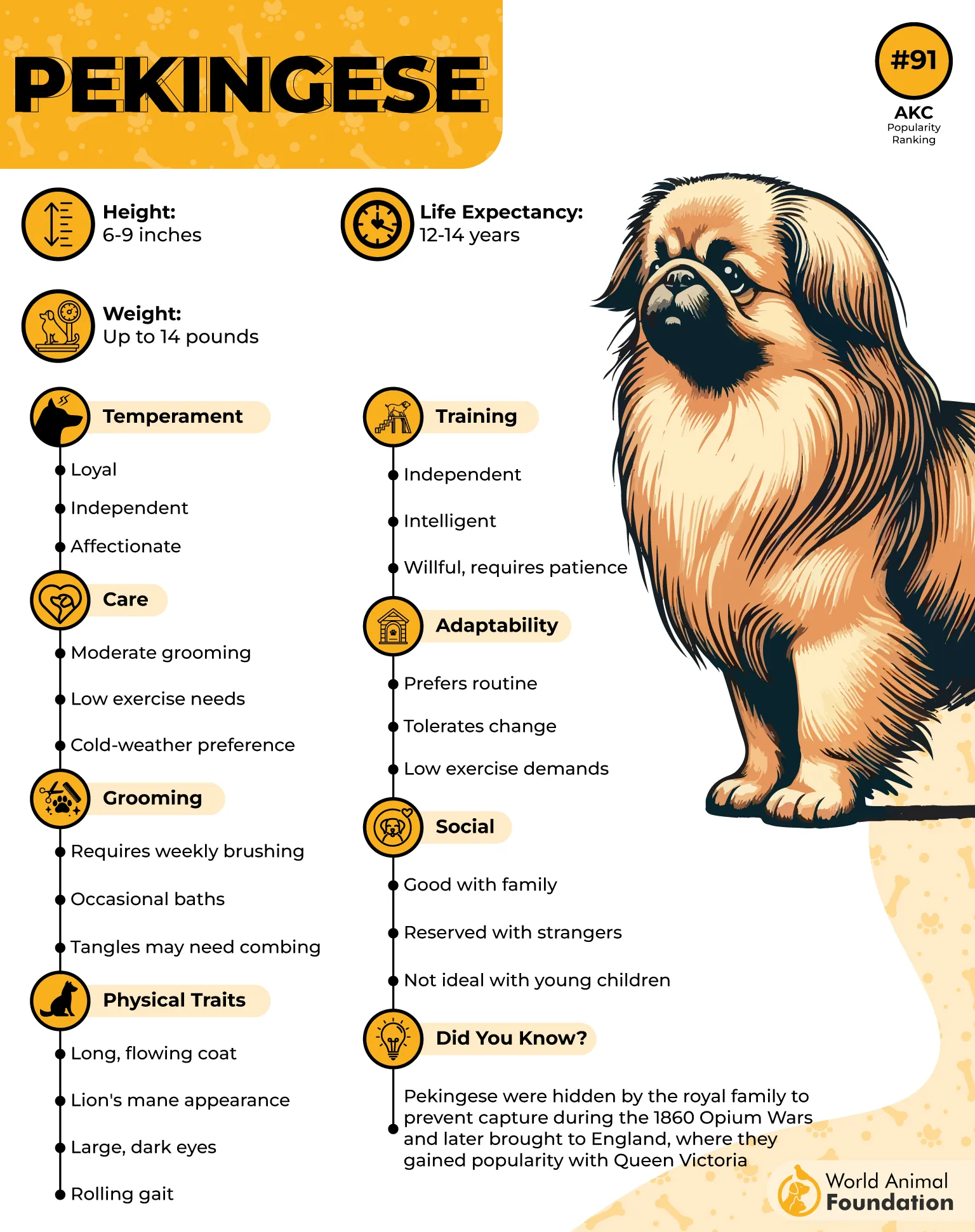
Pekingese’s coat requires brushing several times a week, if not daily, and it is essential to remove dirt and debris and to prevent the coat from becoming matted. Using appropriate grooming tools, such as a slicker brush and a metal comb, can help manage the coat effectively. Additionally, misting the coat with water before brushing can prevent breakage and facilitate smoother grooming sessions.
Bathing the Pekingese is also an important aspect of coat care. It is recommended to bathe the dog every three to six weeks using a high-quality dog shampoo and conditioner to keep the coat clean and hydrated. After bathing, thoroughly drying the coat and brushing it out can prevent matting as it dries.
Pekingese coats shed minimally, making them a suitable choice for individuals with mild allergies. However, their long coats still require consistent grooming to prevent mats and tangles. Regular grooming not only maintains the coat’s beauty but also contributes to the dog’s overall health and comfort.
6. Tibetan Terrier
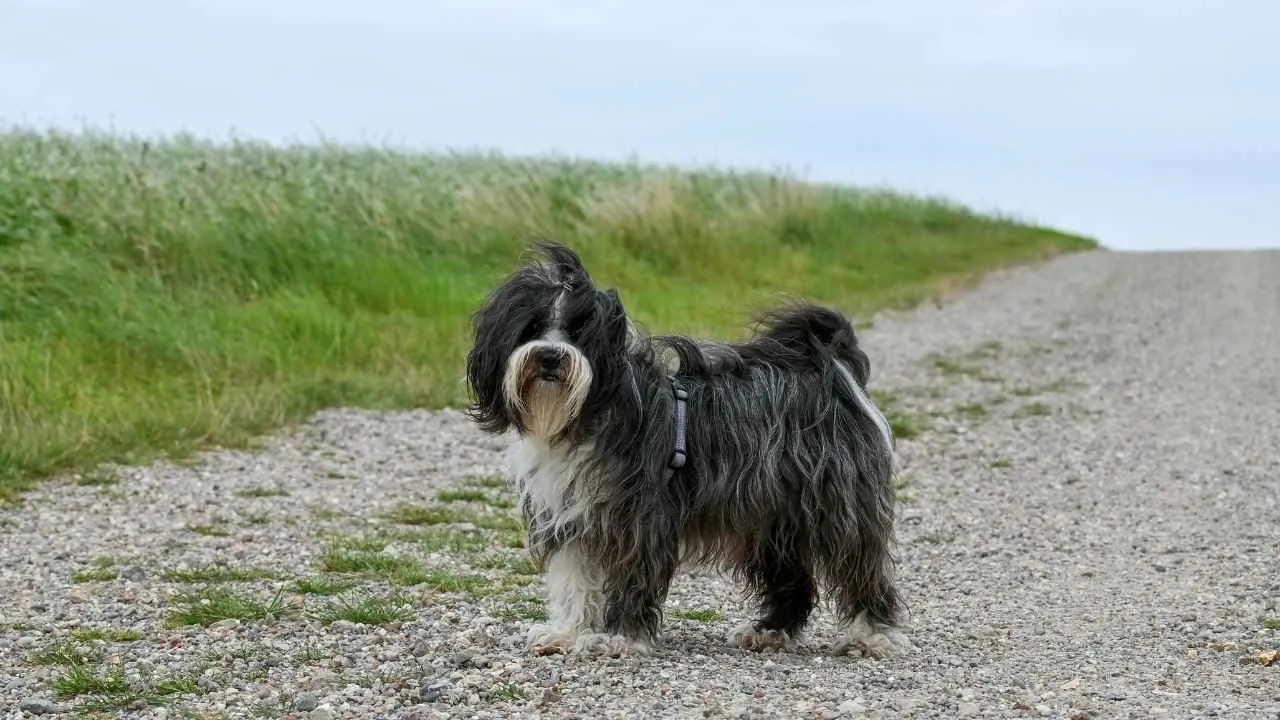
The Tibetan Terrier is a charming breed renowned for its long, flowing coat that exudes elegance and grace. It has a distinctive, long, shaggy coat characterized by a fine, woolly undercoat and a long, fine topcoat that can be either wavy or straight. The hair naturally parts down the middle, cascading over the sides.
This stunning coat not only enhances the breed’s appearance but also serves as protection against the harsh Tibetan climate, reflecting its origins as a companion to Buddhist monks in the Himalayan region.
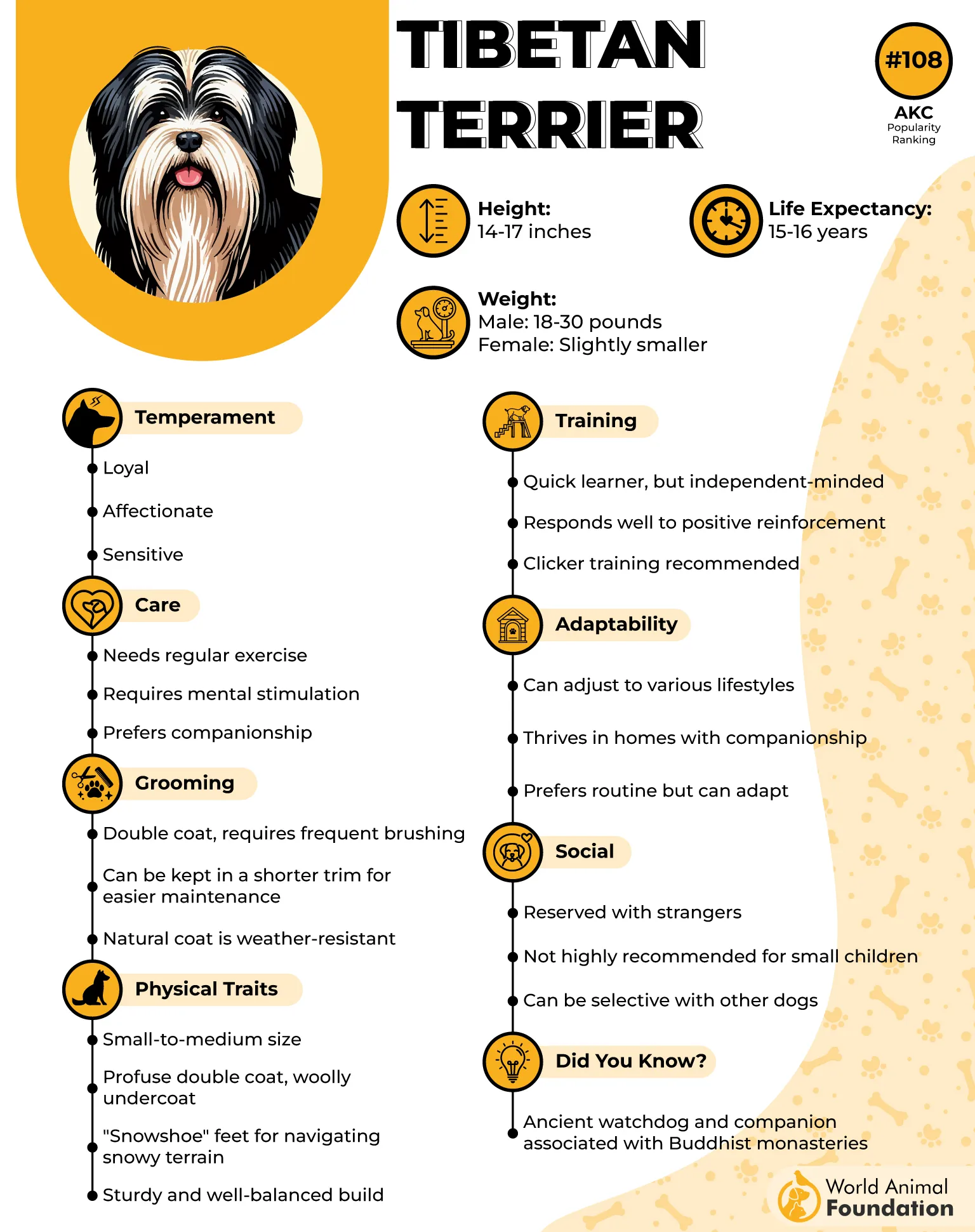
Maintaining the Tibetan Terrier’s luxurious coat requires consistent grooming. Daily brushing is essential to prevent matting and tangling, especially in the dense undercoat. Using tools like a pin brush and a comb with both wide and narrow teeth can help manage the coat effectively.
Despite their long hair, Tibetan Terriers are considered low-shedding dogs, making them a suitable choice for individuals with mild allergies. However, their coat’s maintenance demands a commitment to regular grooming routines.
Purina states Tibetan Terriers possess a friendly and outgoing personality. They are known for their affectionate nature and make excellent companions for families and individuals alike. Their even-tempered demeanor and intelligence make them responsive to training, though they may exhibit a touch of independence. Regular exercise is beneficial to keep them healthy and content.
Prospective owners should be prepared for the grooming commitment involved in maintaining this breed’s distinctive coat. With proper care, the Tibetan Terrier’s coat remains a beautiful and functional aspect of this regal breed.
7. Komondor
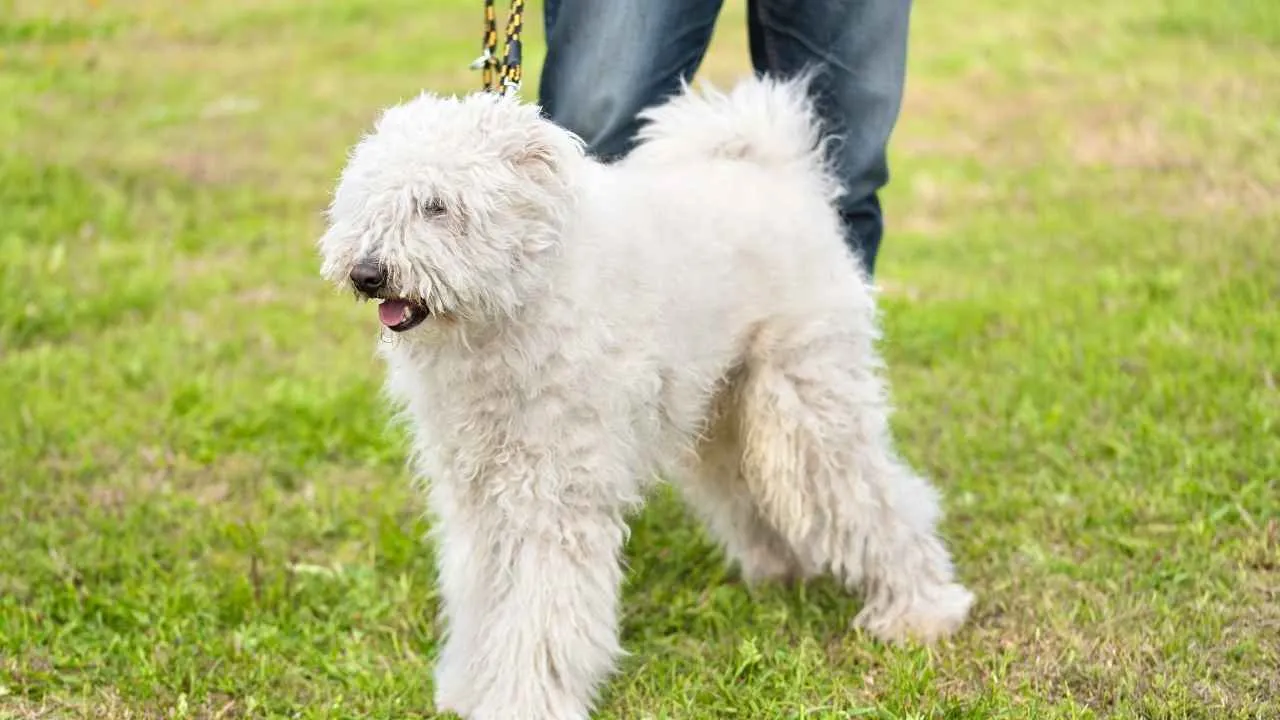
The Komondor’s extended-length, corded coat stands out in the entire canine world. Its iconic cords, growing over 10 inches long, serve as natural armour against harsh weather and predators. A Komondor puppy typically has a curly or wavy coat that will eventually form into distinctive cords as it matures.
Komondor’s hair cycle starts around 8 to 12 months and fully matures by two years, resulting in a highly functional coat suited for their guardian role.
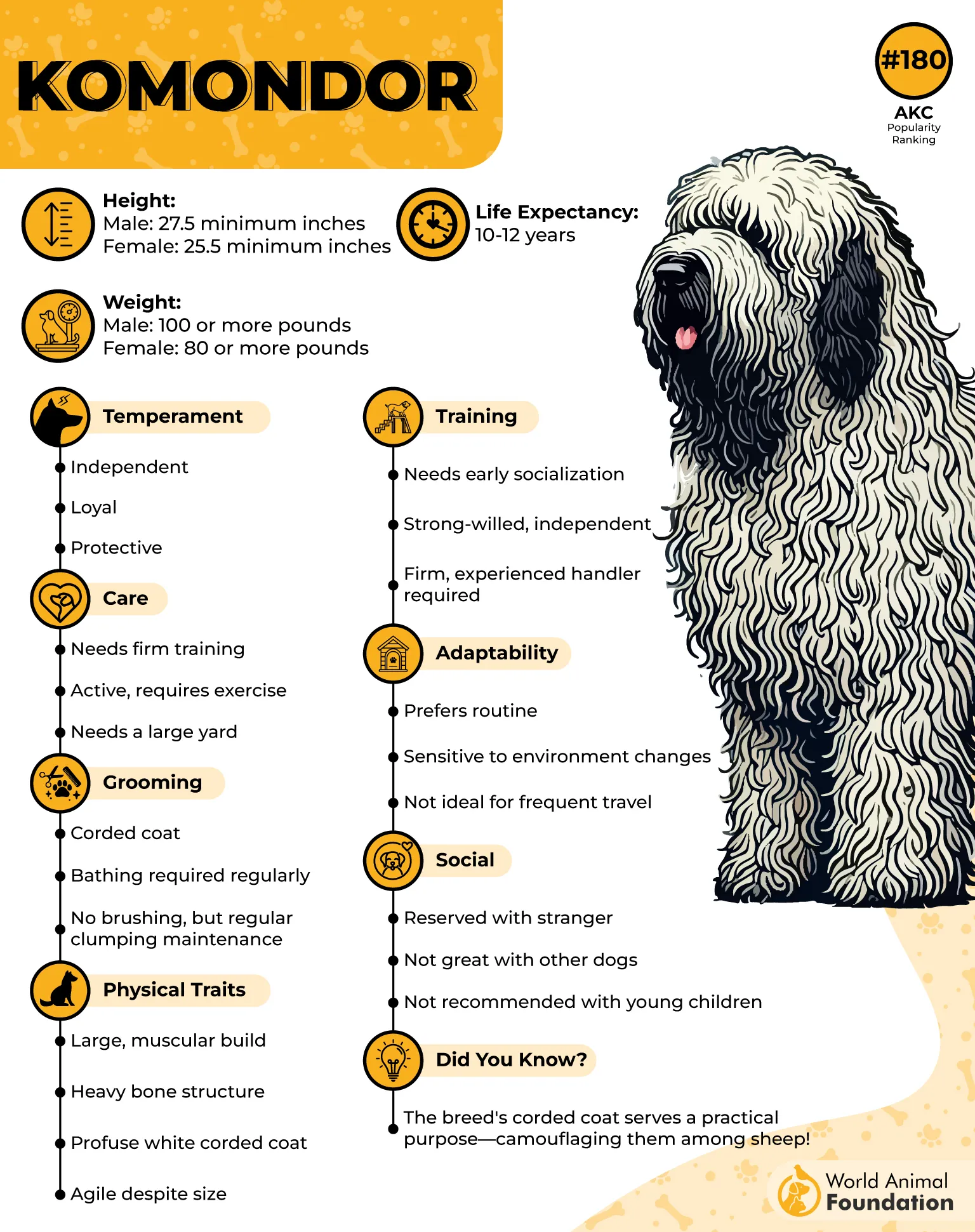
Maintaining the Komondor’s corded coat demands a unique grooming approach. Instead of brushing, the cords must be separated by hand to prevent matting and skin issues. Regular maintenance, which takes hours each week, is crucial and often benefits from the assistance of a professional groomer experienced with corded coats.
Beyond its appearance, the Komondor’s coat serves crucial survival purposes. Komondors were originally bred in Hungary as livestock guardian dogs, specifically to protect herds of sheep and cattle. Their distinctive corded coat helps them blend in with the sheep they guard and provides protection from weather and predators.
Standing over 27.5 inches tall and weighing more than 100 pounds, the Komondor is a powerful and agile dog. Their majestic white cords leave an unforgettable impression. As a devoted companion in the right home, a Komondor can become a gentle, protective presence—an extraordinary guardian and one of the most distinctive pets.
8. Puli
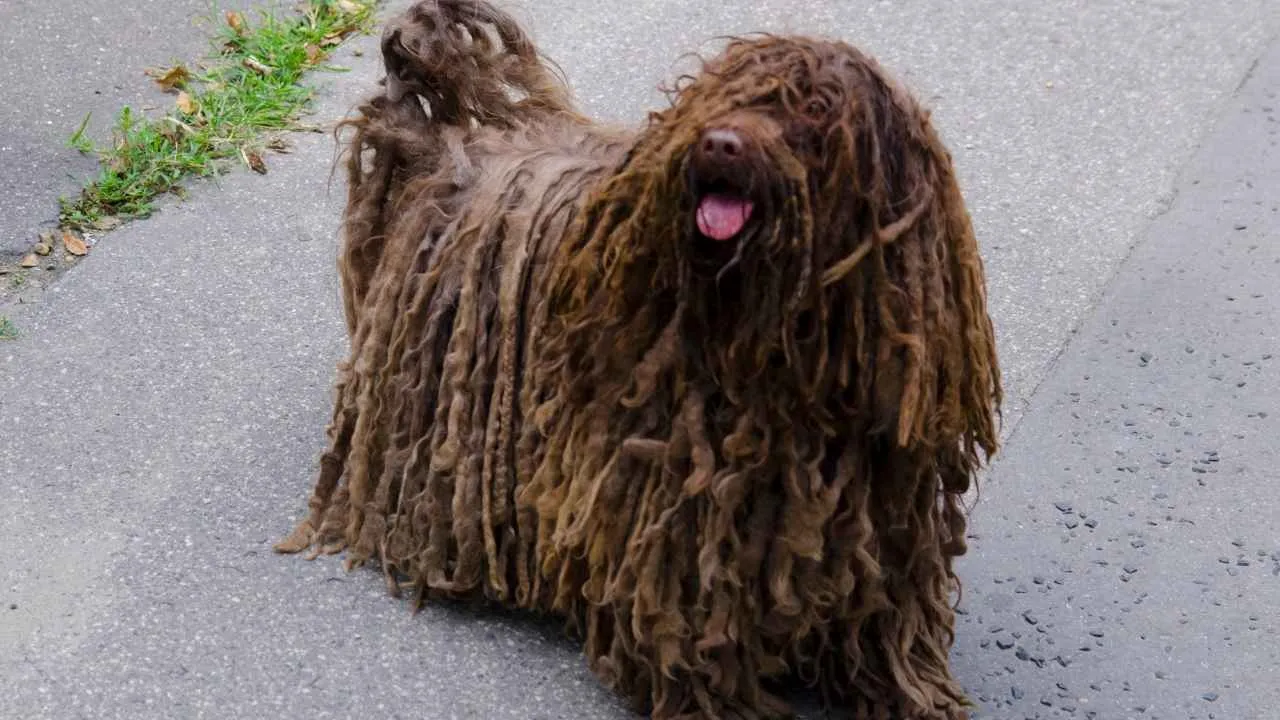
The Puli is a distinctive Hungarian herding breed renowned for its long, corded coat that sets it apart from other long-haired dog breeds. Puli’s coat is naturally curly or wavy, forming dense cords that protect against the elements.
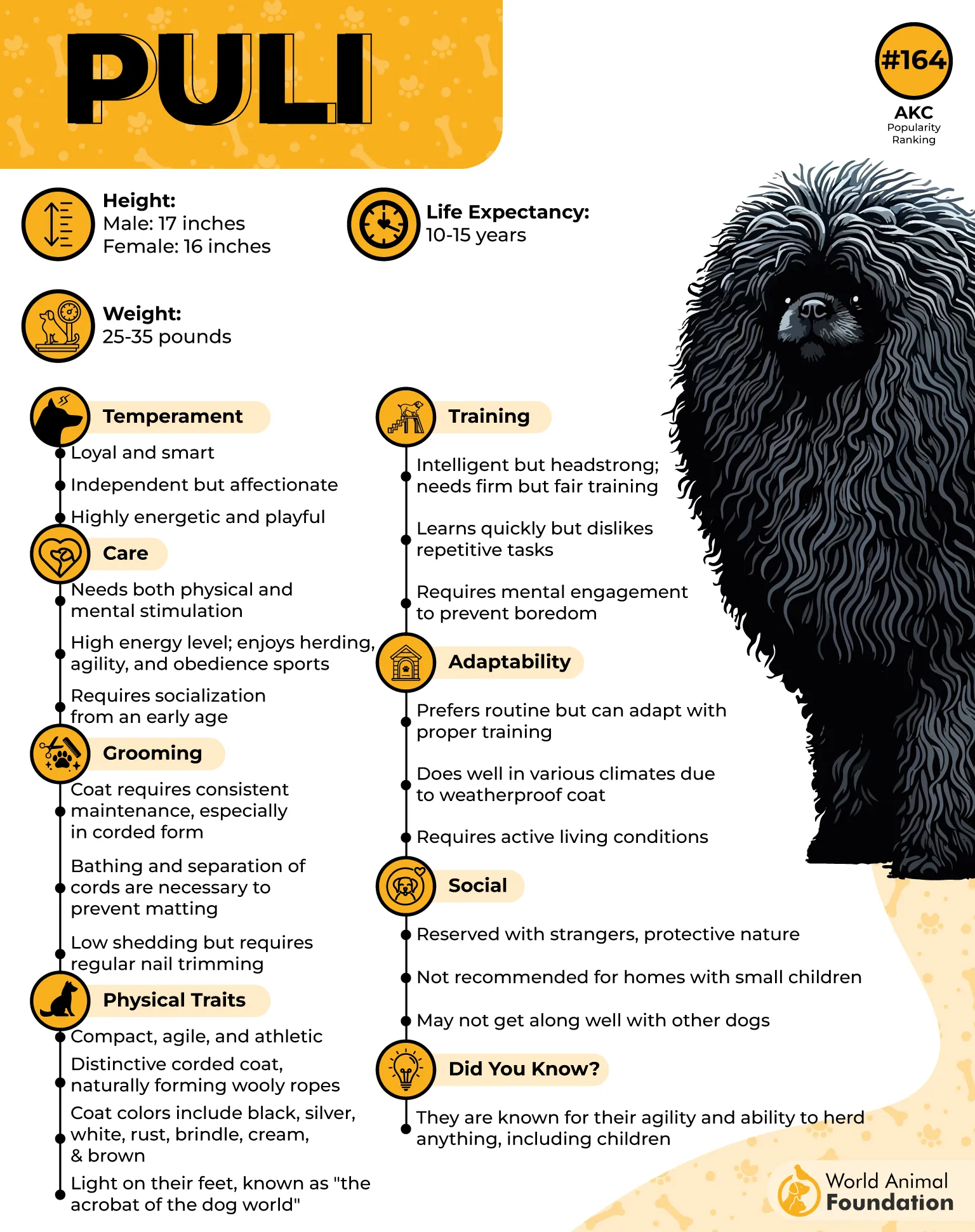
This unique coat structure is a result of a double-layered system: a soft, woolly undercoat and a coarser outer coat that naturally mats into cords over time. These cords, which can vary in texture from thinner to thicker, contribute to the Puli’s voluminous appearance and are a hallmark of the breed’s distinctive look.
Maintaining the Puli’s corded coat requires a dedicated grooming regimen. Daily grooming is essential to prevent matting and to keep the cords neat and clean. Some owners choose to brush out the cords, while others allow them to form naturally. Regardless of the approach, regular maintenance is crucial to ensure Puli’s health and pristine appearance.
As noted by PetMD, Pulik (plural of puli) are not low-shedding dogs despite their extended coat type. However, they require grooming to manage their cords.
Their dense coat provides insulation and protection, making them well-suited for various climates. However, the coat’s density can cause the dog to overheat if not properly maintained, especially in warmer weather. Therefore, owners should ensure that the Puli has access to shade and fresh water during hot conditions.
Beyond their unique coat, Pulis are known for their agility and intelligence. They are highly trainable, excel in various dog sports, and make great family pets.
9. Yorkshire Terrier
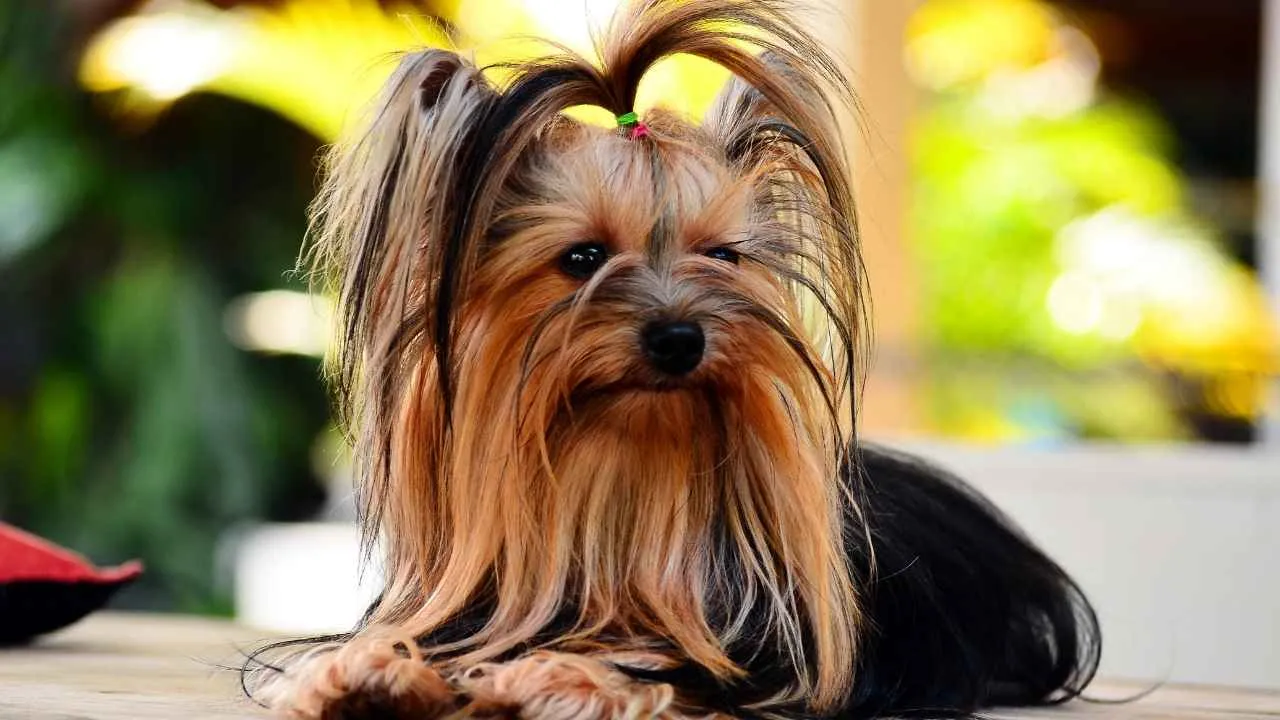
The Yorkshire Terrier, affectionately known as the Yorkie, is a toy breed celebrated for its long, silky coat that resembles human hair. This fine, straight hair grows continuously and requires meticulous care to maintain its glossy appearance. Yorkies have a single-layer coat without an undercoat, making them low-shedding and hypoallergenic for some individuals.
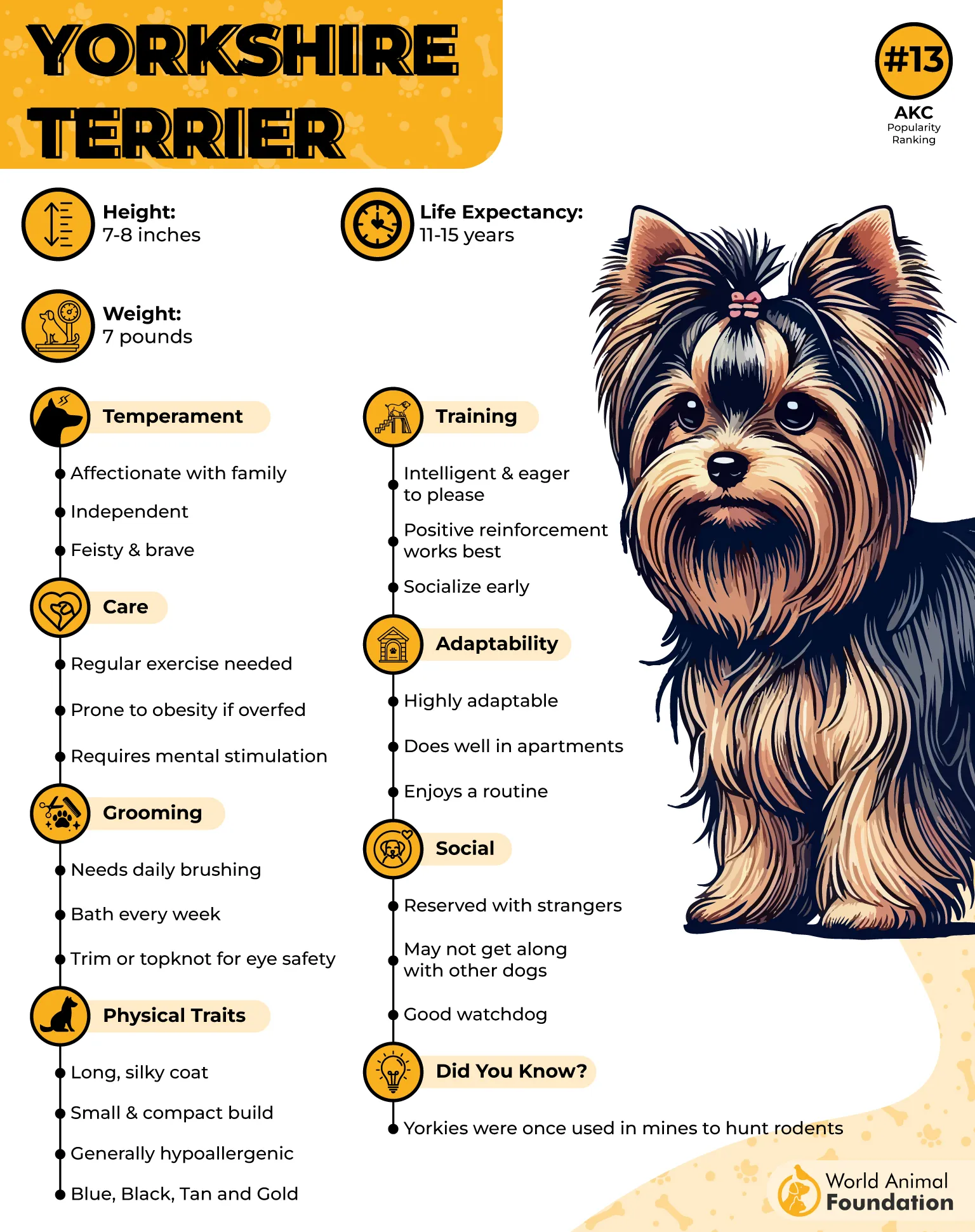
To preserve the beauty of a Yorkie’s coat, regular grooming is essential. Using a slicker brush helps prevent tangles and mats, while a wide-toothed comb can be used to detangle hair around sensitive areas. Brushing not only keeps the coat tangle-free but also promotes healthy skin by distributing natural oils.
Bathing should be done with a gentle dog shampoo to avoid stripping the coat of its natural oils. After bathing, it’s important to thoroughly dry the coat to prevent dampness, which can lead to skin issues. Some owners opt to wrap the coat in a protective covering to maintain its straightness and prevent breakage.
Yorkshire Terriers’ coat serves as a reflection of their overall health and well-being. A well-maintained coat indicates a healthy, happy dog, while a neglected coat can be a sign of underlying health issues. Therefore, grooming is not just about aesthetics but also about ensuring the dog’s comfort and health.
Yorkshire Terriers’ long, silky coat is a defining characteristic that requires dedication and care. With proper grooming, this breed’s coat is a beautiful and functional aspect of its overall health and charm.
10. Maltese
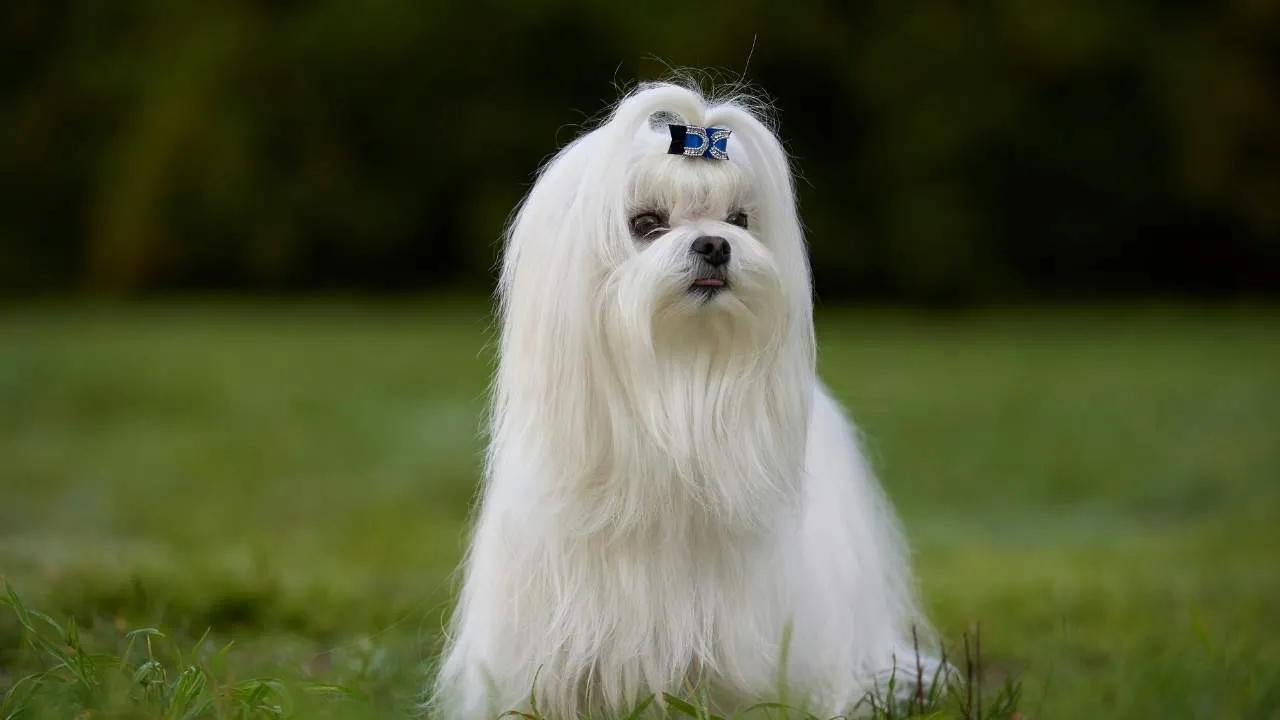
The Maltese is best known for its long, silky white coat, which is its most distinctive feature. The coat is straight and fine, giving the dog an elegant and refined appearance. Due to its fine texture, the Maltese’s coat requires regular grooming to prevent tangling and matting, making it an important part of the breed’s care routine.
The Maltese’s coat grows continuously, and it does not shed like many other dogs. Instead, it requires frequent brushing to maintain its smooth, flowing look. Daily grooming is essential to keep the coat free from knots, and many owners schedule professional grooming sessions to ensure the best care.
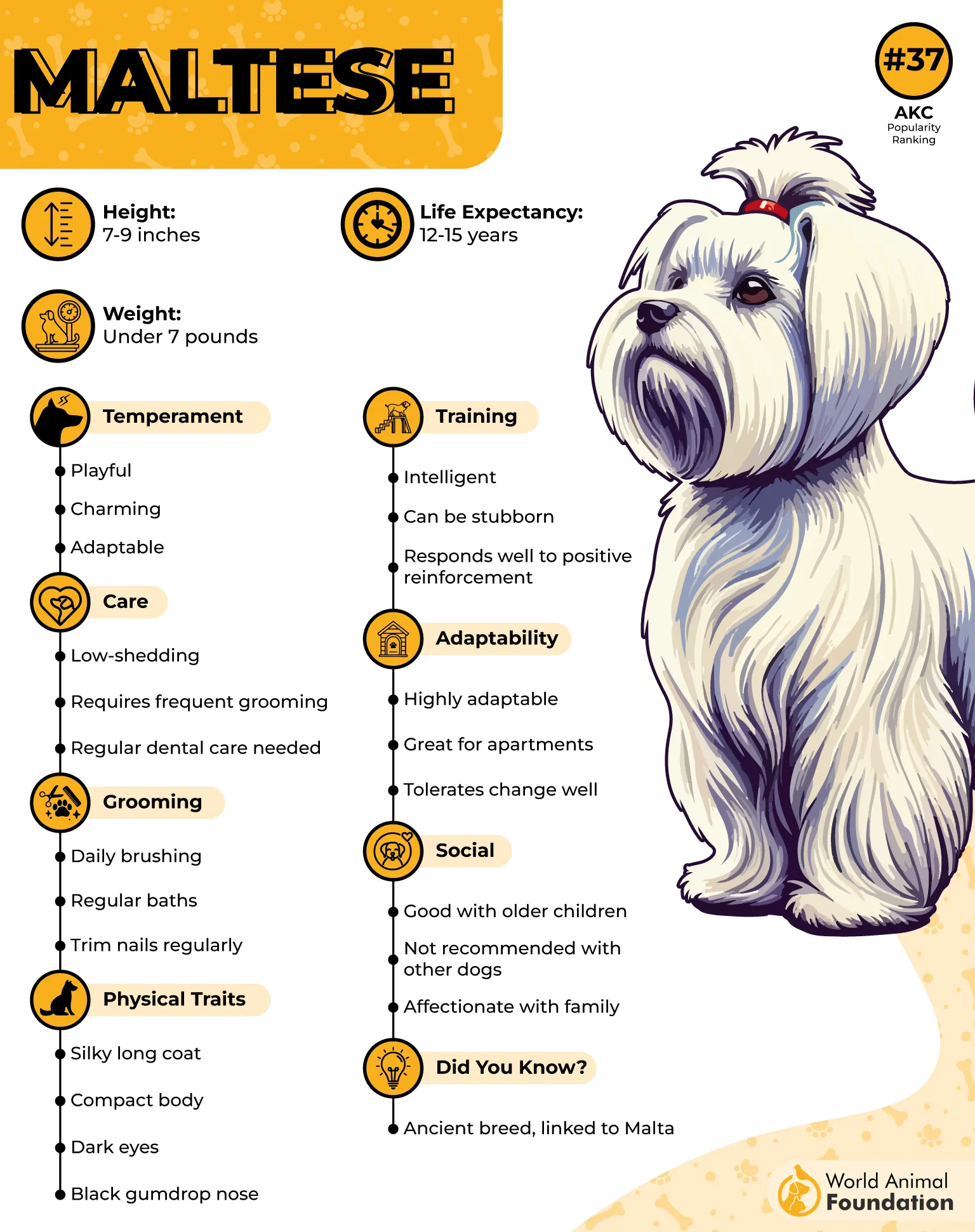
While the Maltese’s coat can grow quite long, many pet owners choose to trim it for convenience. This helps avoid the weight of long hair while still preserving the breed’s signature elegant look. Regular trimming and care help the coat stay healthy and manageable.
The Maltese’s coat is lightweight and soft, but it still requires attention to maintain its natural beauty. Grooming not only keeps the coat looking pristine but also prevents discomfort caused by mats or tangles. Owners must commit to occasional professional grooming to keep the Maltese’s coat in top condition.
Maltese’s luxurious coat is a defining characteristic of the breed, and proper grooming is essential to its care. With regular brushing and attention, the Maltese’s silky white coat can remain as beautiful and striking as its personality.
Conclusion:
Dog breeds with lengthy coats bring a special kind of beauty and devotion to their families. From the grand Bernese Mountain Dog to the tiny Shih Tzu, their fluffy coats and rich hair length stand out among other breeds. Certain breeds with a long double coat, like the Golden Retriever and Alaskan Malamute, require more grooming than short-haired dogs, but their loyalty and charm make the effort worthwhile.
Whether you’re drawn to the elegance of a fluffy white coat, the striking patterns of blue merle, or the hardworking spirit of breeds like Border Collies, these dogs need regular care, bonding time, and a commitment to exercise daily. No matter the size—from larger companions to little dogs like the Cocker Spaniel—choosing the right breed means finding a true, lifelong friend among these great pets.


